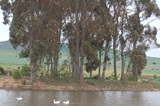Weaver species
Choose different species from drop-down list and press 'Go' button. See Full species list.Ruvu Weaver Ploceus holoxanthus
IUCN: n/a Discovery: 118Categories: golden,
News items about species
Discovery
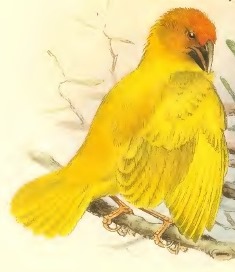
figure from Shelley 1905b 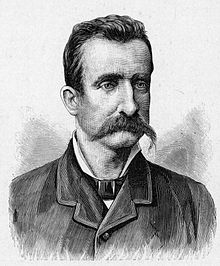
figure from wikipedia 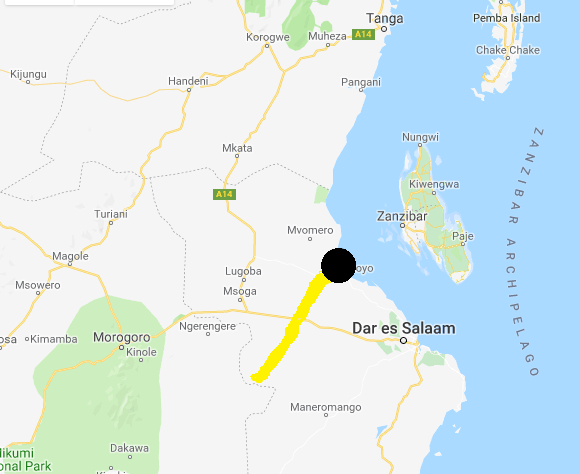
(yellow), type locality black dot IntroductionThe Ruvu Weaver was formally described by Karel Johan Gustav Hartlaub, a German physician and ornithologist.The Ruvu Weaver was first collected by Friedrich Bohndorff, a German researcher and ornithologist. Bohndorff took part in the Austro-Hungarian Congo Expedition, 1885-87, on which he collected the type of the Bob-tailed Weaver). In 1889 Bohndorff joined as a dragoman of the Schutztruppe under Hermann von Wissmann (1853-1905) in German East Africa, due to the "Arab revolt" 1888-1890, a resistance movement against the attempt of the German East African Society (DOAG) to extend their rule over the Zanzibar coastal strip of today's Tanzania. In 1890 Bohndorff was assigned as deck officer on the Mtoni ferry between Bagamoyo and Zanzibar Island, before returning to Berlin in 1892 (from wikipedia). It must have been during 1890 that Bohndorff collected the types of the Ruvu Weaver with other avian specimens which were passed on to Emin Pascha [Hartlaub 1891b p1] when Stanley and Emin arrived in Bagamoyo in 1890 (wikipedia). Emin sent his collections mostly to Hartlaub who described the Ruvu Weaver. However, none of the Ruvu Weaver specimens are known to be in Museum in Bremen where Hartlaub was based. Shelley 1905b gives the collection date as March, while Hartert 1919a, Turner 2011a and Lecroy 2014a give January, which is more likely from a historical point. The Ruvu Weaver was only illustrated by Shelley 1905b but there are some recent photos of males and females. Scientific citationPloceus holoxanthus Hartlaub 1891b, Abh. Naturk. Ver. Bremen 12:22, Mtoni.Meaning of namesholoxanthus, Greek: holos, complete, entire; Gr. xanthos, yellow.First English nameBohndorff's Golden Weaver (Shelley 1905b).Alternate namesBohndorff's Golden Weaver.CollectorFriedrich Bohndorff.Date collectedJanuary 1890.Locality collectedMtoni, lower reaches of the Kingani R (now Ruvu River), Tanzania.Type specimensThe types are adult males in the AMNH Museum (AMNH 724738, Lecroy 2014a). |
The above is based on Weaver Wednesday 2, a weekly series about the discovery of each weaver species.
This species text first appeared as
on
1. Basic biology
| coming |
The above is based on Weaver Wednesday, a weekly series about weaver species.
This species text first appeared as
on
2. Breeding facts
Breeding information based on Handbook of the Birds of the World, Vol. 15.
3. Photos of Weaver Nests
 Vm 5911 | 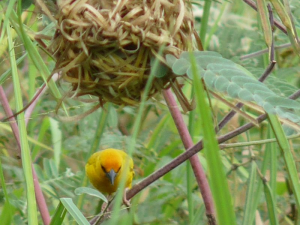 Vm 5680 |  Vm 5186 |
Thumb-nails of most recent PHOWN records - click on one to see its full record
See all PHOWN records for this species here.
PHOWN (Photos of Weaver Nests) provides valuable info on breeding distribution and colony sizes of weavers.
You can contribute by registering and submitting photos at Virtual Museum webpage.
4. Breeding distribution
Google map showing distribution (For species with small ranges you need to zoom in at the correct area to see the range):
yellow blob - range of weaver species; read more about this here.
![]() - PHOWN records with photos
- PHOWN records with photos
![]() - PHOWN records with no photos (Nest Record Cards, other records)
- PHOWN records with no photos (Nest Record Cards, other records)
![]() - Birdpix records
- Birdpix records
![]() - comments on out of range records, or interesting records
- comments on out of range records, or interesting records
![]() - type locality
- type locality
CLICK on the marker on the map to see individual record details.
5. Range changes
Not South African speciesThe above is based on Weaver Wednesday 3, a weekly series about range changes in South African weaver species.
This species text first appeared as
n/a








